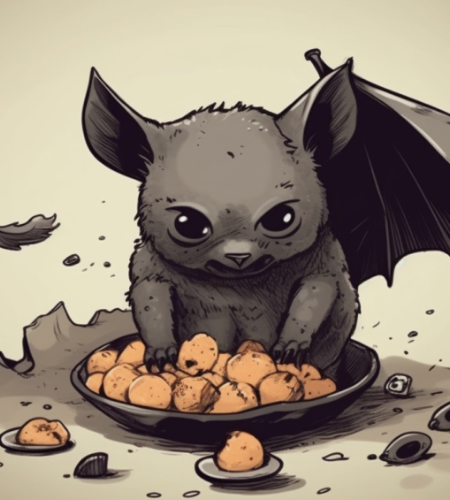Bats are mysterious animals and are considered the only mammals capable of flight. They have adjusted to diverse habitats and food sources. These animals are usually found in the tropical regions of the Earth. Bats are also considered the most prolonged mammals, with some living over thirty years or more. Therefore, apart from the species of bats, their ecology, texture, color, feed, and more, a question still arises. How long can a bat live without food? Knowing the survival and challenges, their part and effect on the ecosystem is critical.
How Long Can a Bat Live Without Food
This essay explores the factors that affect how long a bat can live without food.
Preface to eating habits and Conservation
Bats have adapted to mixed territories. There are various survival tactics and perils of bats and their position in the balance of ecology. They even impact directly or indirectly on human health. The diet, metabolic systems, behavior, and physiology affect their eating system.
Bats cope with food starvation in multiple ways. Humans should consider the significance of bat conservation and their activities, risking survival.
Type and Distribution of Bats
Bats can be found in every habitat, from tropical, desert, or polar areas. Bats have developed distinct diets, sizes, morphology, and conducts to fit their ecology. They feed on fruits, pollen, animals, or even blood. Moreover, they exist alone or form large groups. This diversity and dispersal of bats affect their food and survival.
Likewise, fruit-eating bats meet seasonal changes in their sources. Insect-eating bats may rely on climate and humidity for their prey activity. Bats in mild or cold areas may have severe winters limiting their food choices.
Metabolism and Body Temperature
Bats have a high metabolism and body temperature compared to other animals of the same size. Flying is an actively demanding activity. It takes 50% of their body weight per dark to meet their energy demands. Yet, bats can hold their body temperature in response to surroundings or food lack.
Torpor is a short energy-saving condition lasting from a few hours to days. Hibernation is a long energy-saving form lasting from weeks to months. Bats can reduce their water loss by dropping their temperature and living longer without eating.
Energy Saving States of Bats
Hibernation and torpor actively lower metabolic, heart, and breathing speeds. Hibernation is a seasonal event in winter when food is lacking, and the temperature is low. It applies a deep sleep that is difficult to arouse.
Torpor is a day-to-day event that arises when food sources are inconsistent or inaccessible. It concerns a light sleep that is easy to revive. Both states allow them to save energy and water and live longer. Yet, they have some risks, like less immunity and predation risk.
Bat Fat Reserves
Fat reserves are vital for bats to persist without nutrition. They are stored in the gut, back, or tail. Bats use it to hold their vitality and reform moderate body temperature. The dose and rate of fat deficit vary relying on the types and the needs. Thus, they can persist for weeks or months without eating and leaning on their fat reserves.

Alternative Strategies to Cope up
Migration and swarming are two methods they use to manage food deficits. Migration is the seasonal activity of bats from one area to another in pursuit of food or proper habitats. Swarming is the quick collection of bats at distinct sites for mating or colonial aims.
Migration helps them locate new sources, avoid extreme weather, or evade predators. Swarming helps them find spouses, support social bonds, or share info.
Water Balance of Bats
Water balance is a critical factor for bats to survive for long periods. It is hard to live in arid habitats or during migration or swarming. Water balance is the ratio between the body’s input and water loss.
Bats lose water via various methods. It includes respiration, evaporation, or urination. Bats refill water through different sources. They drink, lick, or absorb moisture from their food or climate. Bats can lose up to 15% of their water daily.
Echolocation as an essential adaption
Echolocation is a critical adaptation that allows bats to find food at night. It is a method in which bats eject high-frequency sounds and hear the echoes that dart back from things in their habitat. They select their target’s area, size, form, speed, and length by analyzing the sounds.
Bats are well adjusted to this process, as they have specialized organs and networks. They have big ears that can catch light echoes on their nose or mouth. They have intricated vocal cords that can modulate their sounds’ frequency, vigor, and time. Bats articulate sounds up to 200 kHz and see objects around 30 meters out.
Future Researches
Future research are done on bat survival without food. It is a very suitable and critical topic, as bats encounter many dangers from human actions, climate flux, and diseases. Researchers are working on how climate change affects food and habitats and their adaptations to altering environments.
They are even working on how human trouble affects the conduct and physiology of bats. A deeper insight is done into the genetic variation that can improve their adaptability or resilience to stressors.
Conclusion
Bats are unique animals that can live for weeks or months without feed. It depends on the species and the states of the bats. They have developed adaptions that allow them to store energy and water.
They store it during times of food lack or adverse climate. Yet, bats also face many dangers from predators, disorders, and human actions that can lower their food and habitat rates. Thus, saving bats and their ecology from collapse and trouble is vital.
FAQs on How Long Can a Bat Live Without Food
How can bats find food at night?
Bats find food in the dark by emitting and listening to the echoes that reflect from things or prey. Some bats use senses, like smell or vision, to find food.
What are the water sources for bats when they go without nutrition?
Bats get water from diverse origins. They can consume from rivers, ponds, or reservoirs. They even lick raindrops from their wings. Still, they have specialized systems that help them hold water.
I hope so you enjoy our article, do check out more of our amazing articles.
